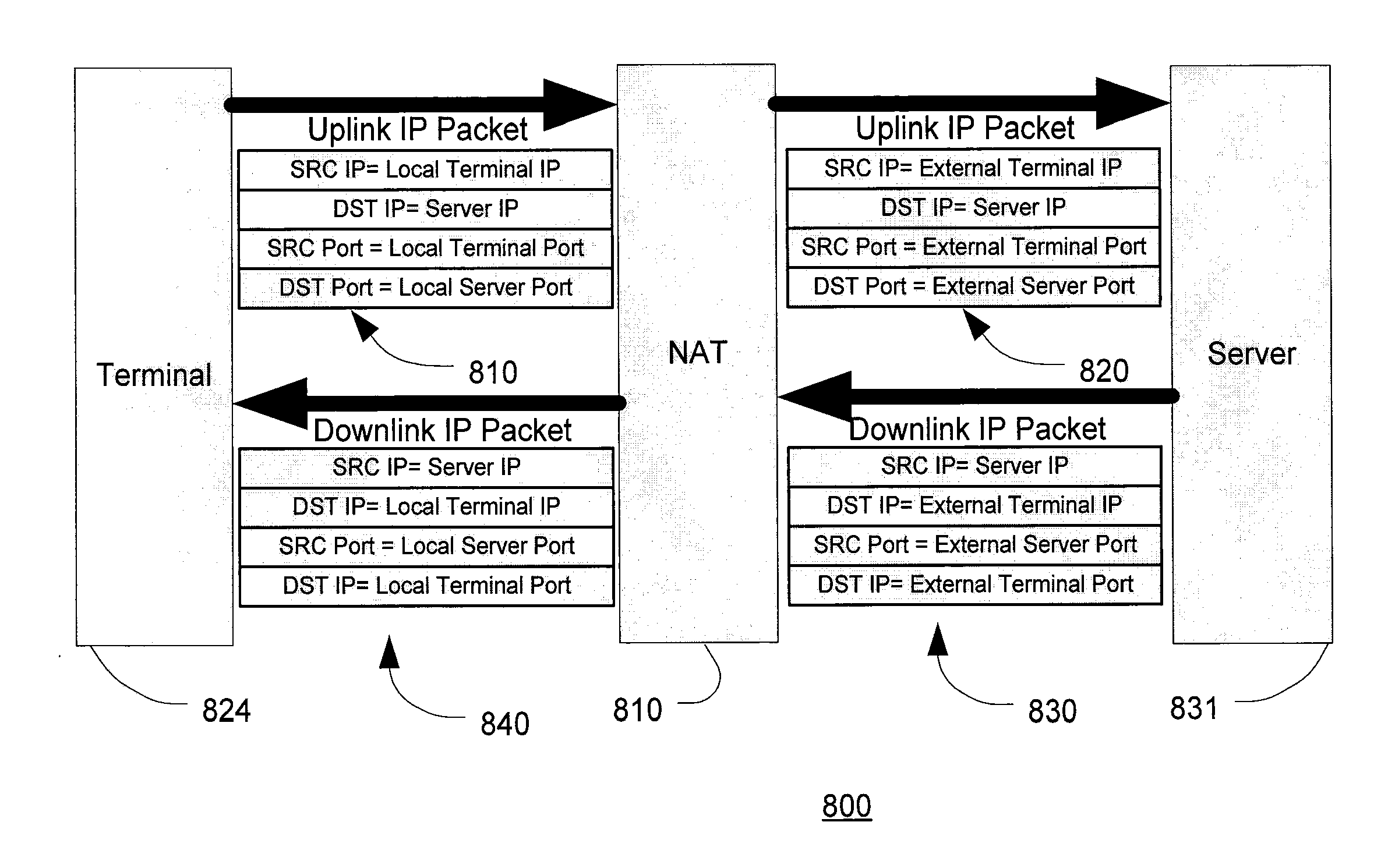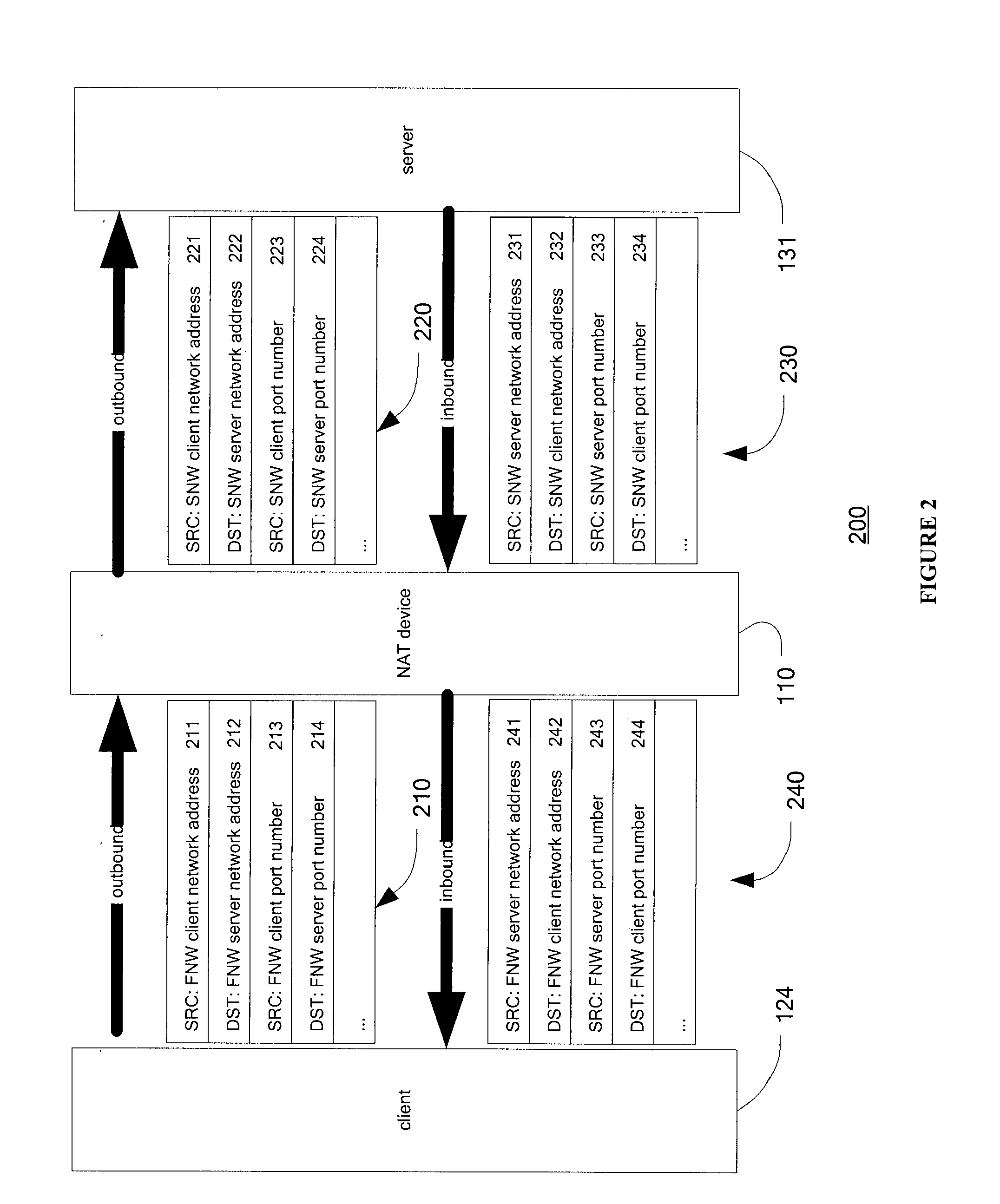Method and apparatus for network port and network address translation
a network port and address translation technology, applied in the field of multi-computer data transfer systems, can solve the problems of limiting the usefulness of existing nat implementations, ipv6 adoption can be costly, and udp does not provide the sequencing or flow control of tcp
- Summary
- Abstract
- Description
- Claims
- Application Information
AI Technical Summary
Problems solved by technology
Method used
Image
Examples
example 1
[0097]FIG. 5 illustrates a sequence diagram 500 of an example method according to an embodiment of the present invention for use in a system comprising client 501, NAT device 502, and server 503. The method includes procedure 510 during which the client is activated and attached to and registered with a first network. The client obtains IP address 10.1.2.3, for example via dynamic host control protocol (DHCP) from a DHCP server. The client IP address is part of a private IP address space assigned for communication within the first network between clients including client 501 and NAT device 502. Public IP addresses are being used for communication within the second network between servers including server 503 and NAT device 502. The DHCP server may be integrated with NAT device 502 or a different element.
[0098]Before requesting activation of a DFR, the client 501 determines a FNW server IP address, a FNW client port, and a FNW server port. The client 501 may further determine one or ...
example 2
[0104]FIG. 6 illustrates a sequence diagram 600 of an example method according to another embodiment of the present invention. Example 2 differs from Example 1 generally in that DFR request messages of client 601 additionally include a SNW client port and a SNW server port, which in contrast to Example 1, are now prescribed by client 601 and no longer left to be decided or selected by NAT device 602. This requires different configurations of client 601, NAT device 602 and the communications and procedures 620, 630, and 640. Procedure 610, and communications 650 and 660 are similar to corresponding procedure 510, and communications 550 and 560.
[0105]As illustrated in FIG. 6, the example method can be used in an example system including client 601, NAT device 602, and server 603. The method includes procedure 610 during which the client is activated and attached to and registered with the network. The client obtains private IP address 10.1.2.3, for example via dynamic host control pro...
example 3
[0110]FIG. 7 illustrates a sequence diagram 700 of an example method according to another embodiment of the present invention. Example 3 differs from Example 2 generally in that DFR request messages of client 701 additionally include a SNW client port range and a SNW server port range which in contrast to Example 2 are now again left to be decided by NAT device 702 but within prescribed ranges specified in a DFR request. This embodiment requires different configurations of client 701, NAT device 702 and the communications and procedures 720, 730, and 740. Procedure 710 and communications 750 and 760 are similar to corresponding procedure 610 and communications 650 and 660.
[0111]As illustrated in FIG. 7, the example method can be used in an example system including client 701, NAT device 702, and server 703. The method includes procedure 710 during which the client is activated and attached to and registered with the network. The client obtains private IP address 10.1.2.3, for exampl...
PUM
 Login to View More
Login to View More Abstract
Description
Claims
Application Information
 Login to View More
Login to View More - R&D
- Intellectual Property
- Life Sciences
- Materials
- Tech Scout
- Unparalleled Data Quality
- Higher Quality Content
- 60% Fewer Hallucinations
Browse by: Latest US Patents, China's latest patents, Technical Efficacy Thesaurus, Application Domain, Technology Topic, Popular Technical Reports.
© 2025 PatSnap. All rights reserved.Legal|Privacy policy|Modern Slavery Act Transparency Statement|Sitemap|About US| Contact US: help@patsnap.com



